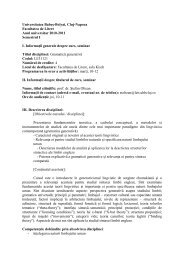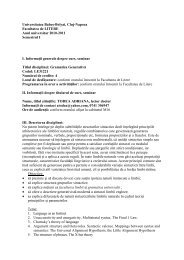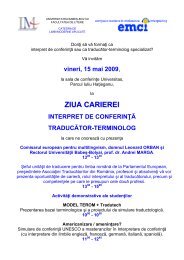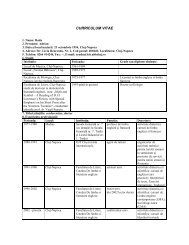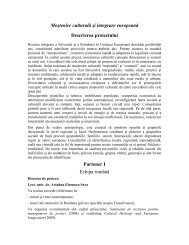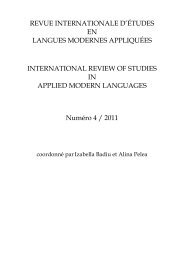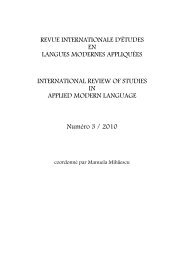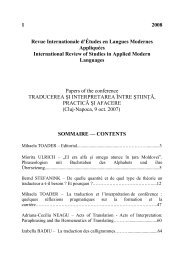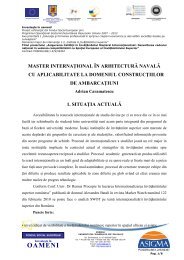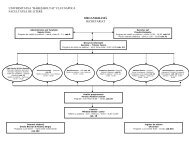Dimensiuni ale limbajului n context carceral
Dimensiuni ale limbajului n context carceral
Dimensiuni ale limbajului n context carceral
You also want an ePaper? Increase the reach of your titles
YUMPU automatically turns print PDFs into web optimized ePapers that Google loves.
‘chronotope’ which is extended between reality and dream, between the object and its projection. However,<br />
during my analysis I shall use the term “hymen” 1 in order to make my enquiries much more accurate. This<br />
hymen is exactly the extension – both in time and space – between reality (object) and its projection.<br />
At the level of imagery, the poem starts with the image of the setting sun which automatically implies<br />
the coming of the night, a moment of peace, solitude and nostalgia at the same time. The sunset in itself is the<br />
cause of melancholic intimations of mortality. However, the term mortality is too strong to be used in this<br />
<strong>context</strong>. Consequently, it would be more appropriate to use the syntagm “ecstasy of dream” when speaking<br />
about matters connected to the proximity of death. Consequently, one cannot speak about death in this poem<br />
although certain critics have understood the nostalgia of the speaker as a result of a beloved person’s death.<br />
On the other hand, dream is a result of sleep, a process which implies the slowing down of bodily sensation<br />
and metabolism, a state in which the human body is closest to death, the absence of movement inside the<br />
body. The sun going down may be seen as the textual mark of this transgression towards sleep, a phase in<br />
which the speaker does not make the difference between reality and projection. This hesitation between reality<br />
and dream is reflected in the use of the words ‘I almost dream’. Thus the landscape becomes figurative of the<br />
speaker’s projected depression as he awaits for the coming of the tide. The environment is not the only<br />
element which is under the process of projection; the interlocutor which the poem is addressed to has the same<br />
fate. It is included, though absent, into an identical state along with the speaker.<br />
In addition to this smooth flow of sentiments, the sound of the water that ‘frets, uncomforted of dream’<br />
becomes a lullaby of sleep imposing a certain rhythm upon the speaker and the reader at the same time. It is a<br />
sort of alpha sound, a primordial sound which brings body, mind, and soul into complete relaxation. Both<br />
depression and loss are the feelings with which the speaker falls into sleep. Consequently, speaking in a<br />
Freudian manner 2 , having this start, the dream that is going to come is more or less unsurprising.<br />
The beginning of the dream is textually marked by the use of ‘as if’ (after all, dreams are the world of<br />
‘as if’). This ‘as if’ also reflects the speaker’s approximate awareness that his perception has some degree of<br />
projection. With the fourth stanza the reader participates in the fascinating process of dream ecstasy. Actually,<br />
1 Here I am using J. Derrida’s term which he introduced for the first time in his Dissemination. To J. Derrida, “hymen” shows itself<br />
in the articulation of meaning in general. “Non-presence, the gaping void of desire, and presence, the fullness of enjoyment, amount<br />
to the same. By the same token, there is no longer any textual difference between the image and the thing, the empty signifier and<br />
the full signified the imitator and the imitated”. It is the fusion that is important, not the different poles of the pair. But it does not<br />
follow, Derrida continues, by virtue of this hymen of confusion, that “there is now only one term, a single one of the differends ... It<br />
is the difference between the two that is no longer functional ... What is lifted, then, is not difference but the different, the<br />
differends, the decidable exteriority of differing terms. Thanks to the confusion and continuity of the hymen, and not in spite of it, a<br />
(pure and impure) difference inscribes itself without any decidable poles, without any independent, irreversible terms”.<br />
(Dissemination, p.209-10). So although hymen represents fusion, it also, by the same movement, leaves the difference intact.<br />
2 At the beginning of his Interpretation of Dreams, Sigmund Freud states: “In the following pages, I shall demonstrate that there is<br />
a psychological technique which makes it possible to interpret dreams, and that on the application of this technique, every dream<br />
will reveal itself as a psychological structure, full of significance, and one which may be assigned to a specific place in the psychic<br />
activities of the waking state. Further, I shall endeavor to elucidate the processes which underlie the strangeness and obscurity of<br />
dreams, and to deduce from these processes the nature of the psychic forces whose conflict or co-operation is responsible for our<br />
dreams.” (cited from http://en.wikipedia.org/wiki/The_Interpretation_of_Dreams, page visited on the 28 th of May, 2008)



